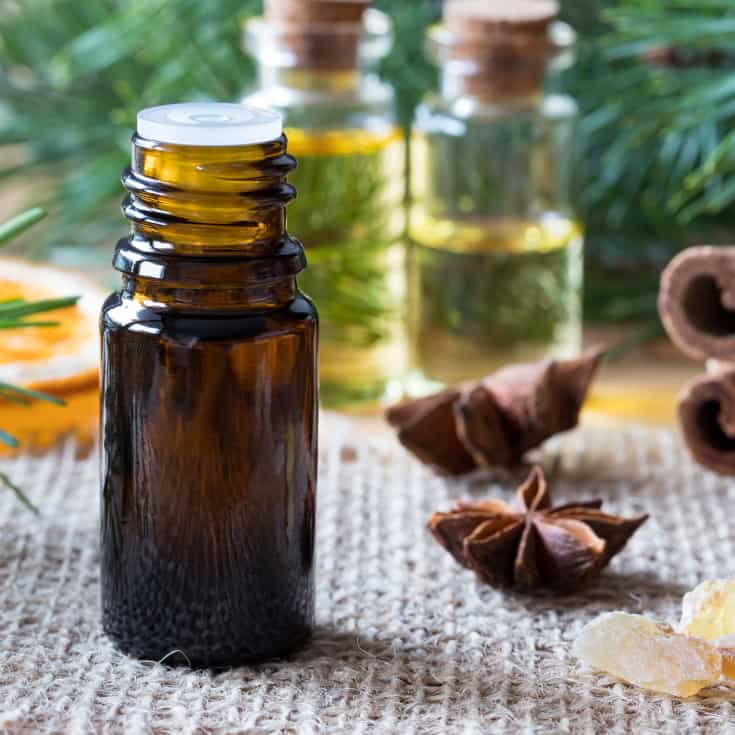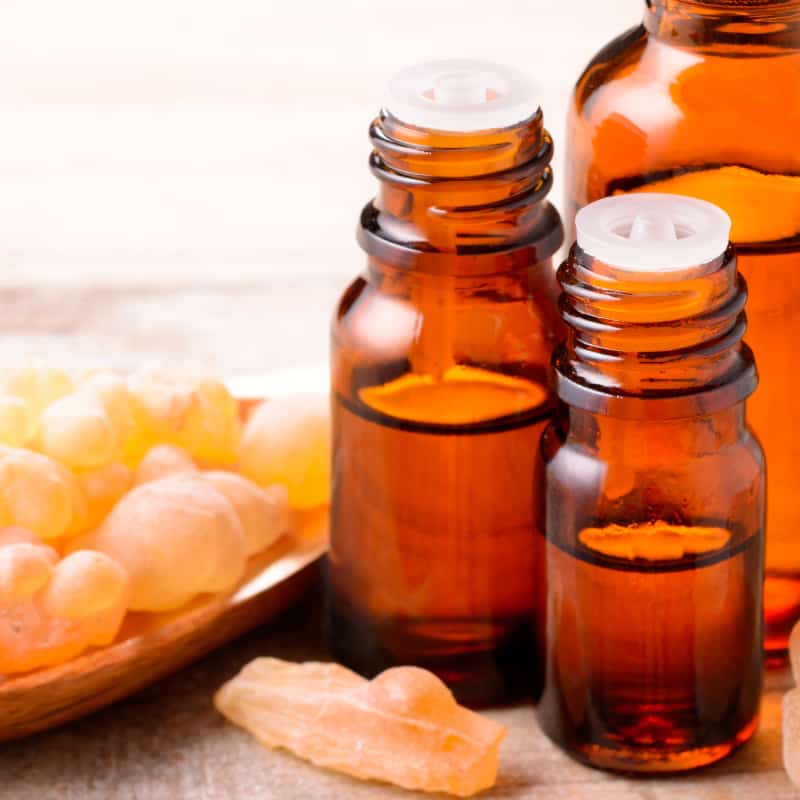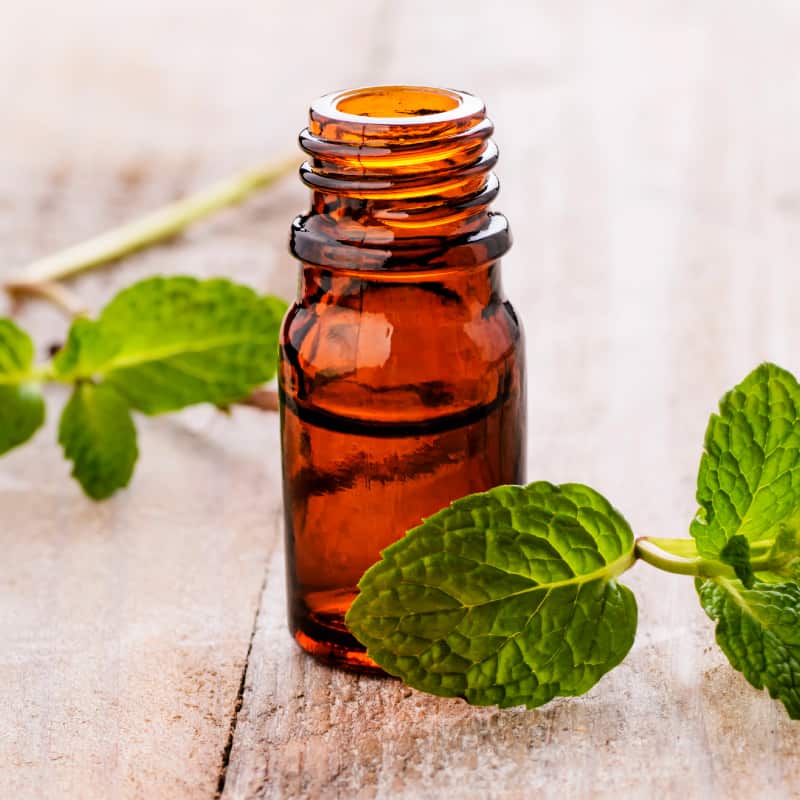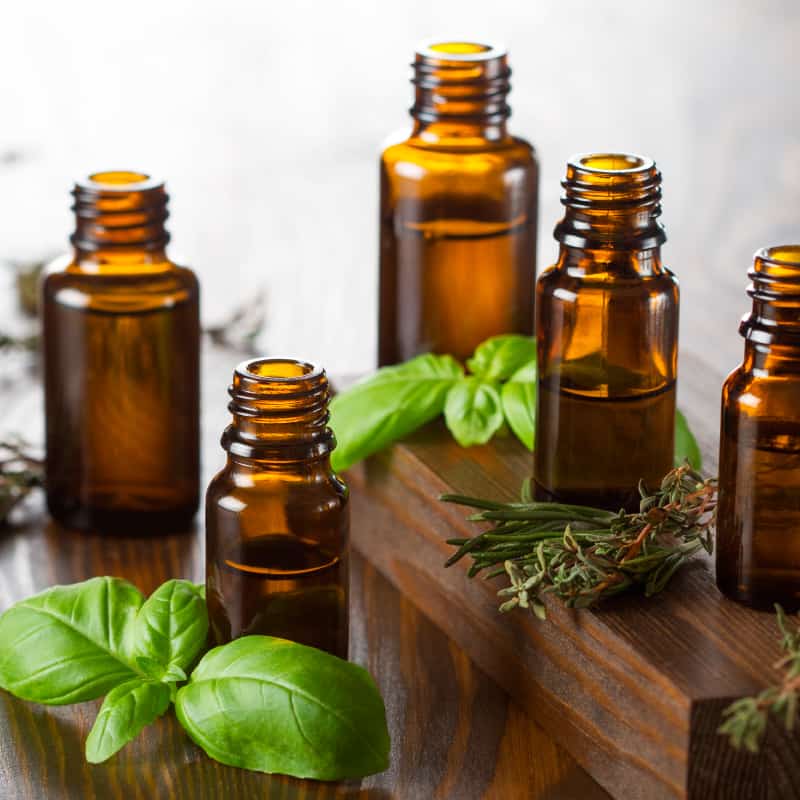This Dr. Axe content is medically reviewed or fact checked to ensure factually accurate information.
With strict editorial sourcing guidelines, we only link to academic research institutions, reputable media sites and, when research is available, medically peer-reviewed studies. Note that the numbers in parentheses (1, 2, etc.) are clickable links to these studies.
The information in our articles is NOT intended to replace a one-on-one relationship with a qualified health care professional and is not intended as medical advice.
This article is based on scientific evidence, written by experts and fact checked by our trained editorial staff. Note that the numbers in parentheses (1, 2, etc.) are clickable links to medically peer-reviewed studies.
Our team includes licensed nutritionists and dietitians, certified health education specialists, as well as certified strength and conditioning specialists, personal trainers and corrective exercise specialists. Our team aims to be not only thorough with its research, but also objective and unbiased.
The information in our articles is NOT intended to replace a one-on-one relationship with a qualified health care professional and is not intended as medical advice.
Top 4 Essential Oils for Headaches
April 20, 2023

Then, of course, there’s the wicked combination of a couple of those causes. If you suffer from frequent headaches and struggle to find an effective treatment, there are no shortage of natural headache remedies out there, but perhaps you haven’t tried the one option that can make the biggest difference. I’m talking about essential oils for headaches.
Millions of people across the world suffer from headaches every day for a variety of reasons, and they’re often not sure what to blame. There are so many causes, including stress, fatigue, allergies, hormones, nutritional deficiencies, constipation, poor posture, low blood sugar, and alcohol or drug consumption.
The most common headache treatment is a painkiller, but these pills come with a host of ugly side effects, like kidney and liver damage — plus they don’t deal with the root of the problem.
Essential oils serve as headache treatments because they safely and effectively treat the headache trigger, getting to the root of the problem instead of minimizing the pain temporarily, just like essential oils for anxiety. Plus, when using essential oils for headaches through a diffuser, there are no nasty side effects, and you are in complete control of your dose — adjusting it for the type of headache you experience.
How Do Essential Oils Treat Headaches?
Unlike pain relievers that are commonly used to treat headaches and migraines today, essential oils serve as a more effective and safer alternative. Essential oils provide relief, aid circulation and reduce stress. They also have a ton of other health benefits and boost your immune system instead of wreaking havoc on your vital organs.
Really, there are few safer, more beneficial ways to soothe headaches than by using essential oils for headaches. It should come as no surprise considering aromatherapy has long been used to treat pain and headaches.
Every headache has a trigger. One major cause of headaches is hormonal changes in women. Fluctuations in estrogen can trigger headaches in many women, especially immediately before or during their periods when estrogen levels drop.
Some women develop migraines during pregnancy or menopause due to hormonal imbalances. Hormonal medications can even worsen headaches, so using essential oils as a gentle and natural treatment is recommended.
Lavender and rosemary oils, for instance, are soothing oils that relieve pain and ease tension. Both oils are used to treat PMS symptoms and hormonal imbalances, including headaches and migraine attacks.
Another major headache trigger is stress, which can be reduced by using lavender and peppermint oil aromatically. Changes in sleeping patterns can also lead to a headache — luckily, lavender works as a mild sedative that helps people suffering from insomnia or a lack of sleep.
Headaches may also be the result of intense physical exertion, allergies, sinus pressure (sinusitis), congestion, certain foods and sensory stimuli. All of these triggers can be minimized or even eliminated with essential oils.
No wonder they have been used for thousands of years — these miracle oils have the ability to treat just about any health condition.
Top 4 Essential Oils for Headaches
1. Peppermint
Peppermint oil uses and benefits include its long-lasting cooling effect on the skin, ability to inhibit muscle contractions and role in stimulating blood flow in the forehead when applied topically.
Applying peppermint essential oil topically across the forehead and on the temples effectively alleviates a tension headache. In a 1996 study, 41 patients (and 164 headache attacks) were analyzed in a placebo-controlled, double-blind crossover study. The peppermint oil was applied topically 15 and 30 minutes after a headache began.
Participants reported pain relief in their headache diaries, and peppermint oil proved to be a well-tolerated and cost-effective alternative to usual headache therapies. There were also no adverse side effects reported after peppermint treatment.
Another important study was conducted in 1995 and published in the International Journal of Phytotherapy and Phytopharmacology. Thirty-two healthy participants were evaluated, and essential oil treatment was investigated by comparing the baseline and treatment measurements. One effective treatment was a combination of peppermint oil, eucalyptus oil and ethanol.
Researchers used a small sponge to apply this mixture, which has a muscle-soothing and mentally relaxing effect, to the participants’ foreheads and temples. When peppermint was mixed with just ethanol, researchers found that it reduced sensitivity during a headache.
In order to improve blood circulation, reduce pain and relieve tension, dilute two to three drops of peppermint oil with coconut oil, and rub it into the shoulders, forehead and back of neck.
2. Lavender
Lavender essential oil has a variety of therapeutic properties. It induces relaxation and relieves tension and stress — working as a sedative, antidepressant, anti-anxiety, anxiolytic, anticonvulsant and calming agent. There is also growing evidence that lavender oil serves as an effective treatment of neurological conditions and disorders.
According to researchers, aromatic and topical use of lavender oil affects the limbic system because the main constituents, linalool and linalyl acetate, are rapidly absorbed through the skin and thought to cause central nervous system depression. For this reason, lavender oil can be used to treat headaches caused by anxiety disorders and related conditions.
Lavender oil benefits include relieving feelings of restlessness and disturbed sleep, two symptoms of headaches. It also regulates serotonin levels, which helps minimize pain in the nervous system that can lead to migraine attacks.
A 2012 study published in European Neurology found that lavender essential oil is an effective and safe modality in the management of migraine headaches. Forty-seven participants were investigated in this placebo-controlled clinical trial.
The treatment group inhaled lavender oil for 15 minutes during a migraine headache. The patients were then asked to record their headache severity and associated symptoms in 30-minute intervals for two hours.
The difference between the control and treatment groups was statistically significant. From the 129 headache cases in the treatment group, 92 responded entirely or partially to lavender oil inhalation. In the control group, 32 out of 68 recorded that headache attacks responded to the placebo.
The percentage of responders was significantly higher in the lavender group than the placebo group.
To reduce muscle tension, boost mood, aid sleep and relieve stress, diffuse five drops of lavender oil at home or in the office. You can also apply lavender oil topically to the back of neck, temples and wrists to relieve stress or tension headaches.
To relax your body and mind, add five to 10 drops of lavender oil to a warm-water bath, and take deep breaths so the sedative properties begin to take effect and reduce headache tension.
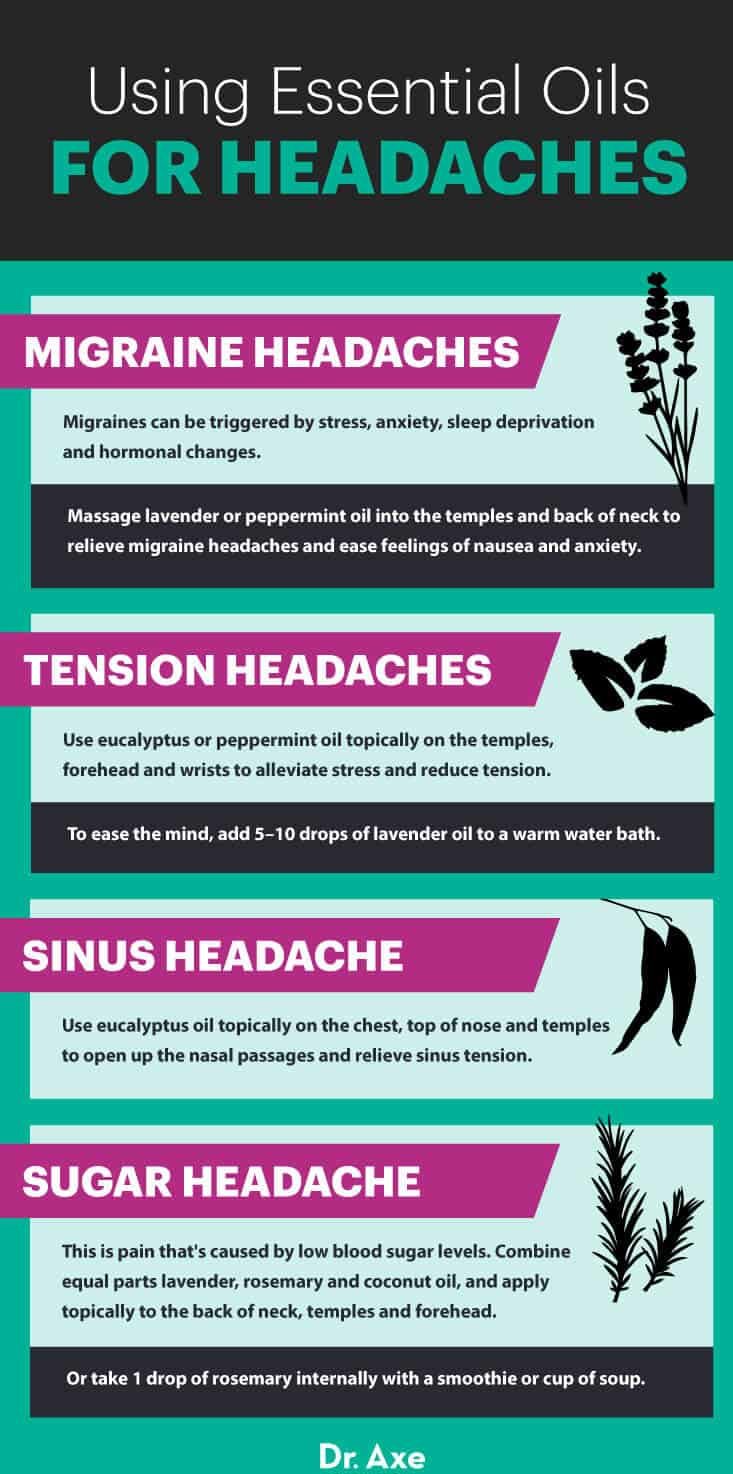
3. Eucalyptus
Eucalyptus works as an expectorant — it helps cleanse the body of toxins and harmful microorganisms. It also opens the nasal airways and eliminates sinus pressure that can lead to a nasty headache, all while promoting emotional balance and boosting mood.
A clinical trial published in Evidence-Based Complementary and Alternative Medicine states that inhaling eucalyptus oil can decrease a person’s pain and blood pressure. The study involved 52 patients who recently underwent total knee replacement surgery.
Eucalyptus oil treatment promoted emotional stability in the patients, reduced edema formation and had anti-inflammatory effects. These pain-reducing and relaxing effects can be beneficial to people suffering from tension headaches.
A 2011 study conducted in Israel evaluated the efficacy of eucalyptus oil when used on patients with respiratory conditions that can lead to cough, sore throat and tension headaches. Patients reported that eucalyptus oil improved breathing and reduced runny nose.
Researchers reported that the oil showed anti-inflammatory effects when used to treat respiratory conditions. It exhibited antibacterial, antiviral and antimicrobial properties that alleviate sinus pressure caused by an inflammatory response.
Dilute two to four drops of eucalyptus oil with a carrier oil, and apply it topically to the chest, back of the neck, temples and forehead. This eliminates nasal buildup and clears your airways — alleviating the sinus tension that leads to a headache or migraine attack.
4. Rosemary
Rosemary essential oil has been used in folk medicine to treat headaches and poor circulation because of its stimulating, anti-inflammatory and analgesic properties. It has a calming effect and improves personal orientation and alertness.
Rosemary oil also reduces stress and emotional triggers that can cause headache attacks. It aids digestion and soothes an upset stomach, as well, which can be a symptom of a severe headache.
An interesting 2013 study published in Addiction and Health evaluated the efficacy of rosemary oil as a form of herbal therapy for the alleviation of withdrawal syndromes in patients with a history of opium abuse. Some opium withdrawal symptoms consist of dysphoric mood, nausea, muscle aches, headaches, fever and insomnia.
Rosemary treatment proved to reduce these symptoms when taken internally for four weeks. It reduced tension and muscle jerks, alleviated pain, improved sleeping patterns, and treated convulsions.
Take one drop of rosemary oil internally by adding it to tea, water or soup when experiencing headache or migraine attacks. To reduce headache pain, mix two drops of rosemary oil with two drops of peppermint oil and one teaspoon of coconut oil, and rub it into the temples, forehead and back of neck.
You can also blend these top four essential oils for headaches with chamomile essential oil, cineole oil, spearmint oil and other oil blends that include other hydrosol flowers.
How to Use Essential Oils for Headache Relief
Migraine Headache:
A migraine is a severe and painful type of headache associated with throbbing pain, nausea and heightened sensitivity to light. Migraines can be triggered by stress, anxiety, sleep deprivation and hormonal changes.
Massage lavender or peppermint oil into the temples and back of neck to relieve migraine headaches and ease feelings of nausea and anxiety.
Tension Headache:
These are called “stress headaches,” and they’re characterized as dull, constant pressure or pain. Tension headaches are typically brought on my feelings of pressure.
Use eucalyptus or peppermint oil topically on the temples, forehead and wrists to alleviate stress and reduce tension. To ease the mind, add five to 10 drops of lavender oil to a warm-water bath, or follow this recipe for my Homemade Healing Bath Salts.
Sinus Headache:
When the membranes of the sinus cavities become inflamed and swollen, you may experience pressure in the forehead area where these cavities are located, resulting in a sinus headache. Use eucalyptus oil topically on the chest, top of nose and temples to open up the nasal passages and relieve sinus tension.
Sugar Headache:
This is pain that’s caused by low blood sugar levels. Combine equal parts lavender, rosemary and coconut oil, and apply topically to the back of neck, temples and forehead. You could take one drop of rosemary internally with a smoothie or cup of soup instead, as well.
Side Effects
When using these essential oils for headaches, especially in sensitive areas like the nose and forehead, it’s best to dilute the oil first. If you have never used an oil before, do a quick patch test on a small area of skin before applying to larger areas.
If you use these oils internally, remember that a little goes a long way. One to two drops should do the trick, and don’t exceed a four-week period without taking a week off from internal use.
Final Thoughts
- The top four essential oils for headaches are peppermint, lavender, eucalyptus and rosemary oil.
- The best way to use essential oils for headaches is by diffusing them with a high-quality diffuser to soothe headaches.
- You can also blend these top four essential oils for headaches with chamomile essential oil, cineole oil, spearmint oil and other oil blends that include other hydrosol flowers.




